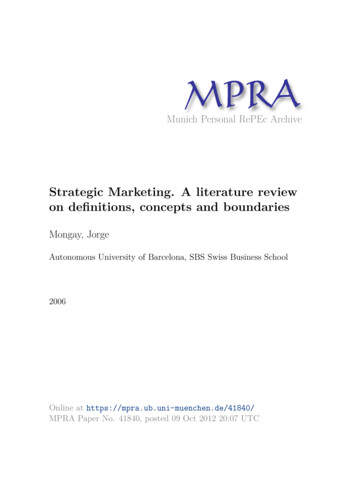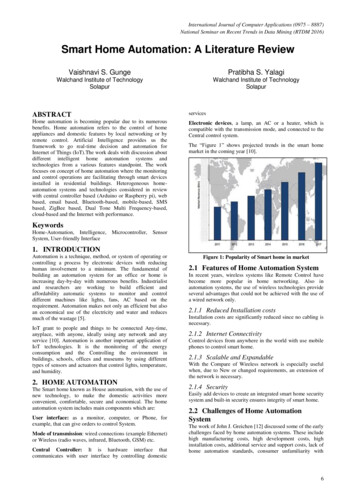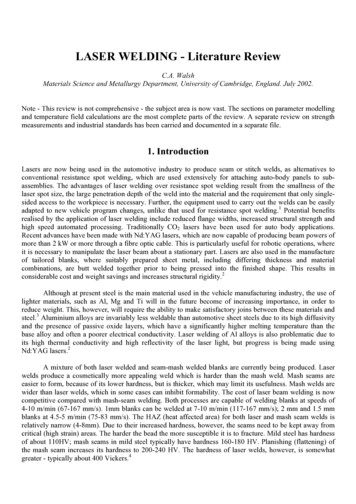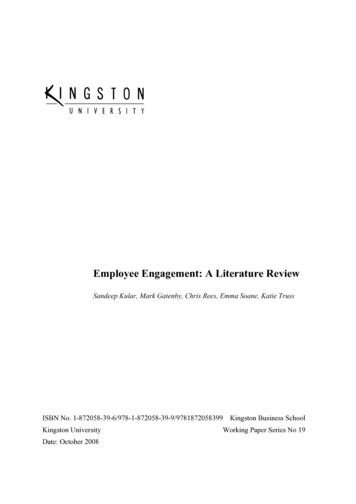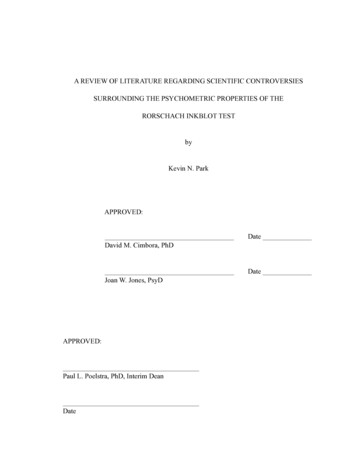
Transcription
Centre for Promoting Ideas, USAwww.ijbssnet.comE-Marketing - A literature Review from a Small Businesses perspectiveDr. Hatem El-GoharyBirmingham City University Business School, Birmingham, UKCairo University Business School, Cairo, EgyptE-mail: hatem.elgohary@bcu.ac.uk, Tel: 0044 -121- 202- 4616AbstractObjectivesThis paper aims to build a structured literature review to the field of E-Marketing. This literature review willprovide an archive of past research points and methodologies related to the studies of E-Marketing to explore,analyze and develop a clear understanding about the different research topics and methodologies implementedin E-Marketing published articles between 2003 and 2010.Prior workThe paper is trying to build on the current body of knowledge in the field of E-Marketing by preparing acomplete archive of the past publications in the field of E-Marketing from 2003 to 2010.ApproachThe paper systematically reviews and categorise the published literature in the field of E-Marketing dependingon the Hanson Internet marketing framework by implementing a three stages methodology and thereafteranalyses and reviews this literature methodologically.ResultsThe literature review covers many areas such as: E-business, E-marketplace, Electronic Commerce, Electronicplatforms, Mobile marketing and many other research areas. Many research gaps were identified in the fieldespecially in the areas of E-Marketing performance as well as E-Marketing adoption in Small Businessenterprises (SBEs). To fill these gaps and extend previous studies within the field, there is a need forconducting research to investigate the relationship between implementing E-Marketing and small businessesperformance. Based on the findings the author highly recommends depending on a triangulation approach inconducting future research in the field of E-Marketing.ImplicationsThe study will provide great benefits for entrepreneurs, policy makers, practitioners, researchers, andeducators though providing a clearer view and deep understanding for all the issues related to the field of EMarketing.ValueThis paper will add to the body of knowledge by investigating and illustrating a survey and systematic reviewof the published work in the field of E-Marketing. Depending on this review, researchers and scholars in thefield of E-Marketing can have a clearer view to set their attitude towards suitable future research studies andmethodologies which in turn will contribute to the related accumulated knowledge in the field.Keywords: E-Marketing, Small Business Enterprises, Internet Marketing, E-Mail Marketing, MobileMarketing, E-Commerce, E-Business, Performance, Literature Review214
International Journal of Business and Social ScienceVol. 1 No. 1; October 20101. IntroductionSmall Business Enterprises (SBEs) do play a major and important role in today’s world economy, and they arerecognised as one of the main contributors to economic, development and employment growth. According toMulhern (1995) 99% of all European companies are small and medium sized (SME) and from 1985-1995 itprovided 66% of the employment in Europe. On the other hand, the revolution in information technology (IT)and communications changed the way people conduct business today.In recent years, increasing numbers of businesses have been using the Internet and other electronic media inconducting their marketing efforts, giving the chance for Electronic Marketing (as a new marketingphenomenon and philosophy) to grow in a very dramatic and dynamic way.From the author point of view, implementing E-Marketing by small business enterprise can change both theshape and nature of its business all over the world. Because the increase usage of the Internet and otherElectronic Marketing tools (i.e.: E-mail, Intranets, Extranets and Mobile phones) in electronic transactionsmight create not only a lot of opportunists for small business enterprises but also can eliminate a lot of itsthreats. From this prospective, it is noticed that the Internet, other electronic media tools and ElectronicMarketing tools are playing a vital and essential role in conducting marketing activities within businessenterprises regardless of its type or size.1.1 Small Business EnterprisesRegardless of the high importance of small business enterprises for any economy, it is noticed that defining ithad always been a difficult thing to do. Accordingly, there is a little agreement between researchers,practitioners, financial institutions and governmental agencies on what defines a small business. Based onthat, small business had been defined in deferent ways in different parts of the world according to nationaland local needs (Theng and Boon 1996; Watson and Everrett 1996). Table 1 summarises the official (or mostcommon definitions) of SBEs used in some countries around the world.Table 1: Criteria of defining SBEs adapted by some countriesCountryUSAEuropeanUnionNo. of employeesUnder 10010 to 49AustraliaCanadaUnder 20Under 500 in mfgand 50 in servicesNoneIndiaUnder 50Under 200 inlabour intensiveTurkey10 to 49Source: El-Gohary (2010)MexicoThailandOther criteriaLess than 5 million annual salesAnnual turnover or global balance less than 10 million Euros Independence(Not exceeding 25% of the capital or voting rights withheld by oneor more companies (or public bodies) which are not themselvesSMEs)NoneLess than 5 million annual salesTotal investment(not exceeding 10 million Indian Rupees inindustrial enterprises and 1 million in service enterprises)NoneNoneNone215
Centre for Promoting Ideas, USAwww.ijbssnet.comFrom table 1 it is noticed that the number of employees is the most often used element in determining thecategory of SBEs in most countries. Furthermore, It also noticed that there is a lack of agreement on whatdefines a small business, for that a standard definition for Small Business Enterprises is highly needed.1.2 E-MarketingElectronic Marketing (E-Marketing) can be viewed as a new philosophy and a modern business practiceinvolved with the marketing of goods, services, information and ideas via the Internet and other electronicmeans. By reviewing the relevant literature it is noticed that definitions of electronic marketing (E-Marketing)vary according to each author's point of view, background and specialization. For that, while Smith andChaffey defines it as: “Achieving marketing objectives through applying digital technologies” (Smith andChaffey, 2005: 11), Strauss and Frost define it as: “The use of electronic data and applications for planningand executing the conception, distribution and pricing of ideas, goods and services to create exchanges thatsatisfy individual and organizational goals” (Strauss and Frost, 2001: 454).On the other hand, the review of the relevant literature revealed that one of the main obstacles in the literatureis the unclear way of dealing with the concept and definition of E-Marketing. In this respect most of theresearchers misused the term E-Marketing; the majority of researchers are using the terms: E-Marketing /Internet-marketing / E-commerce / E-business as equivalents or a deferent wording for the same meaning,which is incorrect because they are deferent. For example, E-Marketing has a broader scope than internetmarketing since Internet Marketing (IM) refers only to the Internet, World Wide Web, e-mails. While EMarketing includes all of that plus all other E-Marketing tools like: Intranets, Extranets and mobile phones. Incontrast with that, E-commerce and E-business have a wider and broader scope than E-Marketing. Thesedifferences can be illustrated in figure 1.Figure 1: Differences between Internet-marketing, E-Marketing, E-commerce and E-BusinessSource: El-Gohary et al (2010)From the author’s point of view implementing Electronic marketing (E-Marketing) by small businessenterprise can change both the shape and nature of SBEs business all over the world. Because the increaseusage of the Internet and other electronic marketing tools (i.e.: Intranets, Extranets and mobile phones) inelectronic transactions might create not only a lot of opportunists for small business enterprises but also caneliminate a lot of its threats.2. Research Problem and QuestionsThe fundamental problem motivating this study is the need to know and understand the different researchpoints covered by the researchers in the field of E-Marketing as well as understanding the differentmethodologies applied by these researchers and trying to evaluate these methodologies to illustrate thesuitable methodologies and methods for future research studies in the field of E-Marketing.216
International Journal of Business and Social ScienceVol. 1 No. 1; October 2010On one hand, preparing a complete archive of the past publications in the field of E-Marketing will help indetermining the different gaps in the literature and consequently help in directing the future research in thefield. On the other hand, as the theory in the field of E-Marketing is still in its infancy stage and yet not wellestablished there is a need for having more well-established studies that can be considered as a step toward atheory building in the field of E-Marketing. These well-established studies need to implement the mostsuitable methodology to the nature of E-Marketing. The current study aims to participate in achieving thisobjective by providing a clear picture about the methodological issues related to studies of E-Marketingpublished between 2003 and 2010.Accordingly, the main two questions that the study attempts to answer are:- What are the different research points covered by the researchers in the field of E-Marketing from 2003 to2010?- What is the most suitable methodology and methods to be used in future research studies in the field of EMarketing?3. Research ObjectivesThe main objective of this research is to: develop a clear understanding about the different research pointsrelated to studies of E-Marketing published between 2003 and 2010 and explore and analyse the differentmethodologies implemented by the researchers in the field of E-Marketing.Consequently, the objectives of this research are as follows:ooooTo provide an archive of past research points related to studies of E-Marketing.To explore and analyze the different methodologies implemented by the researchers in the field of EMarketing.To illustrate and clarify the most suitable methodologies for the future research studies in the field ofE-Marketing.To provide an archive of past methodologies implemented by researchers in the field of E-Marketing.By achieving such goals researchers and scholars in the field of E-Marketing can have a clearer view to settheir attitude towards suitable future research studies and methodologies which in turn will contribute to therelated accumulated knowledge in the field.4. MethodologyThe nature of research on E-Marketing is difficult to conduct due to some specific reasons such as:--The nature of the E-Marketing concept itself. It is still considered as an unclear concept for themajority of both researchers and practitioners, a lot of them are misusing it by mixing between it andsome other concepts like: Internet Marketing, E-Commerce and E-Business while these concepts aretotally different than E-Marketing. For example: while Internet Marketing (IM) is defined as: “the useof the Internet to achieve marketing objectives and support marketing activities” (Eid, 2003: 1-5). ECommerce can be defined as: “the trading of goods and information through the Internet” (Baourakis,et al., 2002: 581) which indicate that E-commerce includes: buying and selling on line, digital valuecreation, virtual marketplaces and storefronts, and new distribution channel intermediaries (Straussand Frost, 2001). Moreover, E-Business is totally different than E-commerce, Internet Marketing andE-Marketing.The relevant research materials related to E-Marketing is highly distributed between many variousjournals.But on the other hand, Hanson (2001) adopted a proposed Internet Marketing (IM) framework. According tothis framework Internet Marketing articles can be found in three types of journals which are:-Marketing journals.Economics, business and management journals.Information systems (IS) and information technology (IT) journals (Figure 2).217
Centre for Promoting Ideas, USAwww.ijbssnet.comFigure 2: Hanson Internet Marketing (IM) frameworkSource: Ngai (2003)By taking into consideration Hanson Internet marketing framework and based on the fact that InternetMarketing is not only one of the main element of E-Marketing but also have the same characteristics, theauthor see that it is suitable to adopt the same framework and methodology implemented by Hanson (2001) inthe current study.4.1 Sample and ProceduresThe author reviewed the literature by implementing three stages search. In the first stage, the author started bydetermining the initial databases that could be considered as the potential publications outlets in the field of EMarketing. Based on that and by taking into consideration: the size of the database, its level of comprehensiveand its collections of reviewed management journals, the following online databases were searched to providea comprehensive bibliography of the E-Marketing literature:-Emerald (MCB) Database;EBSCO Electronic Database;Proquest Direct Database;Science Direct (Elsevier) Database ;ABI/Inform database ; and:University of Bradford catalogue.In the second stage, the search descriptors and time length were determined in the light of E-Marketingcomponents. Based on that, the literature search was based on some descriptors to investigate the differentresearch areas and methodologies applied in the literature of E-Marketing in general and E-Marketing inSmall Business Enterprises (SBEs) in particular. These descriptors was: Electronic Marketing (E-Marketing),Internet Marketing (I-M), Intranet Marketing, Extranet Marketing, E-Business, E-Commerce, ElectronicMarketplace (E-Marketplace), E-mail marketing and Mobile Phone marketing (MM).Although, it is noticed that despite of the fast growth in E-Marketing research in the last decade, it appearsthat only from the late 1980s researches on E-Marketing and Internet Marketing begun to appear in theliterature. Starting with the work of: Malone, Yates and Benjamin (1987 & 1989), crossing by the work of:White (1997), Samiee (1998), Wientzen (2000), Porter (2001) and so on. The literature time period starts from2003 and ends June 2010 as a step towards building a complete archive of the past publications in the field ofE-Marketing from 1993 to 2010.218
International Journal of Business and Social ScienceVol. 1 No. 1; October 2010In stage three, the relevant research studies were identified. The search yielded 365 studies from 89 journals.Although the author was planning in the first place (because of the limited resources regarding time andeffort) to construct a representative un-probability sample from the literature to come up with an accurate andfair representation of the literature characteristics and to investigate the research points, methodologies andmethods used in contemporary E-Marketing research, the author decided to take all the studies resulted fromthe literature into consideration because off the relatively limited number of studies yielded.4.2 Classification MethodEach article of the 365 articles was reviewed carefully and in detail to investigate both: the research points andmethodology applied in it. Then articles were classified according to: Research area, Methodologies, Researchstrategies, Research Methods, Market Studied, Type of study (Empirical/Not Empirical), Sample Unit, Journaland Year of publication.5. Results5.1 Distribution of the research areas of the publicationsThe articles published from 2003 to 2010 in the field of E-Marketing had covered the following researchareas: E-Business, E-Marketplace, Electronic Commerce, Electronic platforms, ICT adoption, Internetmarketing, On-line trust, B2B, Performance evaluation, The Web, Electronic marketing, E-mail Making, Ereadiness, E-relationships, E-security, E-service, E-supply chain management, Internet adaptation, Mobilemarketing and some other research areas as illustrated in table 2.As illustrated in table 2, Electronic Commerce was the major research area covered by researchers from 2003to 2010 with a total number of 92 articles and a percentage of 25.2 % of the total number of articles followedby Electronic Business with a total number of 61 articles and a percentage of 16.7 % of the total number ofarticles. Then comes: Internet marketing with a percentage of 14.5 % of the total number of articles thenMobile Marketing with a percentage of 10.6 % of the total number of articles, Business-to-business (B2B)with a percentage of 5.2 % of the total number of articles and lastly: Electronic Marketing with a percentageof 3.3 % of the total number of articles.Table 2: Distribution of published studies according to the research areasResearch AreaNumber of studies%E-business6116.7%E-marketplace92.4 %Electronic Commerce9225.2 %Electronic platforms30.8 %ICT adoption71.9 %Internet marketing5314.5 %On-line trust30.8 %B2B195.2%Performance evaluation21%219
Centre for Promoting Ideas, USAwww.ijbssnet.comThe Web61.6 %Electronic Marketing123.3 %E-mail Making113.1 %E-readiness30.8 %E-relationships41%E-security92.4 %E-service51.3 %E-supply chain management92.4 %Internet adaptation71.9 %Mobile marketing3910.6 %Other research areas113.1 %Total365100 %By reviewing the distribution of articles studied Electronic Commerce, Electronic Business and InternetMarketing (as the largest three research areas covered by researchers and practitioners in the field of EMarketing) by year of publication it is noticed that:----Most of the E-Commerce articles had been published in 2009 with a percentage of 25 % of the totalnumber of articles followed by year 2003 with a percentage of 22 % of the total number of articles. Itis also noticed that the number of articles published tended to decrease significantly from 2003 to2008 which reflect a decreasing interest from researchers to study Electronic Commerce during thisperiod. Furthermore, the number of articles published tended to increase back from 2009.Most of the E-Business articles had been published in 2010 with a percentage of 26 % of the totalnumber of articles followed by years 2009 and 2004 with a percentage of 23 % and 16 % of the totalnumber of articles respectively.Although most of the Internet Marketing articles had been published in 2009 with a percentage of28% of the total number of articles followed by years 2010 with a percentage of 19 % of the totalnumber of articles, there is no significant deference between most of the years investigated (expect foryear 2008).In general, it is noticed that the number of articles published in the three research areas tended todecrease significantly from 2003 to 2008. Which not only reflect a decreasing interest fromresearchers to study these research areas, but also could reflect an increasing interest of studying someother research areas during the same period of time? To discover if this interest were redirected byresearchers to study E-Marketing the author analysed the distribution of articles studied E-Marketingfrom 2003 to 2010. The results of this analysis (as illustrated in table 4) showed that:o220Most of the E-Marketing articles had been published in 2009 with a percentage of 34 % of thetotal number of articles.
International Journal of Business and Social ScienceVol. 1 No. 1; October 2010oGenerally, there is significant stability in E-Marketing research in the last 8 years.oRegardless of the important role of E-Marketing in conducting marketing activities, there noincreasing interest in studying E-Marketing (all E-Marketing activities not only one of it i.e.Internet Marketing, etc.) by researchers.Table 3: Electronic Commerce, Electronic Bus
enterprise can change both the shape and nature of SBEs business all over the world. Because the increase usage of the Internet and other electronic marketing tools (i.e.: Intranets, Extranets and mobile phones) in electronic transactions might create not only a lot of
